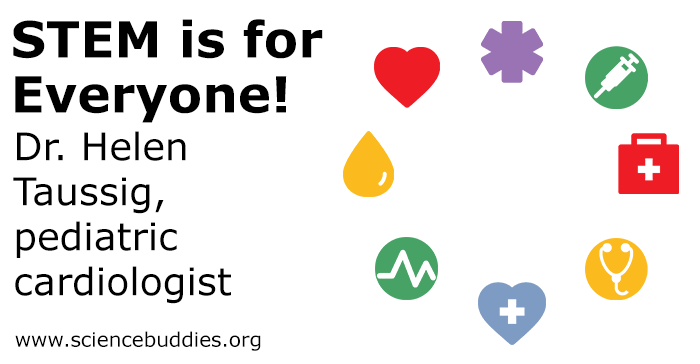STEM is for Everyone: Helen Taussig, Pediatric Cardiologist
Dr. Helen Brooke Taussig was a pioneer in pediatric cardiology and changed the outcome for thousands of children born with blue baby syndrome. Due to hearing loss, Dr. Taussig used her hands to "listen" to heart rhythms.

A Career Studying the Heart
Dr. Helen Brooke Taussig's research and work as a physician made a difference for thousands of babies born with congenital heart defects. She also helped prevent a potential epidemic of birth defects by advocating against the approval of thalidomide in the United States.
Dr. Taussig pursued her education and medical career in the early 1900s, a time when "public health" was suggested as more appropriate for a woman than being a doctor and not all universities granted advanced degrees to women. She was also dyslexic and suffered hearing loss caused by whooping cough. She did not let these challenges stand in her way.
Her story is an inspiring example of a scientist pursuing a passion and succeeding, despite societal and physical challenges.
Treating Blue Baby Syndrome
Today, babies born with anoxemia or "blue baby" syndrome have a better chance at survival because of Dr. Taussig. Blue baby syndrome is often caused by a congenital heart defect. After identifying problems contributing to reduced blood flow to the lungs in children with blue baby syndrome, Dr. Taussig hypothesized a new surgical treatment that was then tested by surgeon Alfred Blalock and Vivien Thomas, a surgical technician. The procedure is now known as the Blalock-Taussig shunt.
Listening to the Heart
Cardiologists rely on a stethoscope to listen to a patient's heart. When Dr. Taussig lost her hearing, she was able to use hearing aids and lipreading for communication, but when treating patients, she used her fingers. She developed a method of "listening" to a child's heart using her fingers and was able to detect problems like heart murmurs through touch.
Dr. Taussig is referred to as the founder of pediatric cardiology. After graduating from Johns Hopkins Medical School in 1927, she served as head of the Children's Heart Clinic at Johns Hopkins Hospital from 1930 to 1936. She continued to work at Johns Hopkins until her retirement in 1963. In 1965, Dr. Taussig was elected as the first woman president of the American Heart Association.
Explore Heart Health and Human Biology with Student Projects and Lessons
Students inspired by Dr. Taussig's story and interested in human biology, heart health, and medicine may enjoy projects like these:
- A Day in the Life of Your Heart: track your pulse throughout the day to see how it changes in response to activities.
- Heart Health: How Does Heart Rate Change with Exercise?: monitor heart rate during different kinds of physical activities to see which ones increase heart rate most.
- Heart Rate Recovery Times: experiment to see if heart rate recovery time is faster for athletes than for non-athletes.
- Make Your Own Stethoscope: learn how a stethoscope works and make and test three different models.
- Modeling the Human Cardiovascular System: The Factors That Affect Blood Flow Rate: build a model of the human cardiovascular system and explore the relationship between the diameter of arteries and blood flow.
- Make a Heart Rate Monitor: design and build a custom heart monitor circuit using electronics and Arduino™.
Educators can teach about health and human biology with lesson plans like these:
Related STEM Careers
The following career profiles help students learn more about careers related to medicine and health:- Cardiovascular Technologist or Technician
- Physician
- Biomedical Engineer
- Health Educator
- Medical Social Worker
- Physician Assistant
- Registered Nurse
Learn More
- Women In Science: Helen Taussig (1898-1986)
- Dr. Helen Brooke Taussig
- Dr. Helen Taussig, 87, Dies; Led In Blue Baby Operation
- Helen B Taussig - A Founder Of Pediatric Cardiology
- Helen Taussig: Warrior Of The Heart
The STEM is for Everyone Series
For more information about this series of profiles of scientists with disabilities and to learn about other scientists and engineers, see the following posts:
- STEM is for Everyone: Scientists with Disabilities
- STEM is for Everyone: Nicholas Saunderson, Blind Mathematician
- STEM is for Everyone: Temple Grandin, Animal Scientist with Autism
- STEM is for Everyone: Geerat Vermeij, a Paleoecologist who is Blind
- STEM is for Everyone: Farida Bedwei, a Computer Scientist with Cerebral Palsy
- STEM is for Everyone: Ralph Braun, Engineer
- STEM is for Everyone: Wanda Díaz-Merced, Astrophysicist
- STEM is for Everyone: Richard Mankin, Entomologist
- STEM is for Everyone: Helen Taussig, Pediatric Cardiologist
- STEM is for Everyone: Annie Jump Cannon, Classifier of Stars
- STEM is for Everyone: Jane Goodall, Zoologist
This post is part of our STEM is for Everyone: Scientists with Disabilities series. This series is made possible by generous support from Mitsubishi Electric America Foundation, a non-profit foundation jointly funded by Mitsubishi Electric Corporation of Japan and its US affiliates, working to make changes for the better by empowering youth with disabilities to lead productive lives.
Categories:
You Might Also Enjoy These Related Posts:
- Women in STEM! More than 60 Scientists and Engineers for Women's History Month
- Black History Month - Learn More About these 38 Scientists for Black History Month!
- Native American Scientists and Engineers--Native American Heritage Month in Science Class
- Hispanic Scientists and Engineers - Hispanic Heritage Month
- Inspiring AAPI Scientists and Engineers - Asian American and Native Hawaiian/Pacific Islander Heritage Month
- Thousands of Tall Paper Towers (and Lots of Tape!)
- STEM is for Everyone: Jane Goodall, Zoologist
- STEM is for Everyone: Annie Jump Cannon, Classifier of Stars









